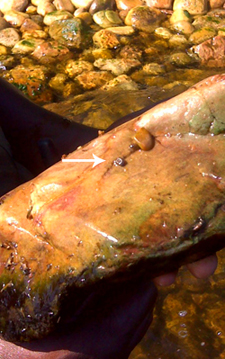Biology

A Biomphalaria snail (indicated by arrow) on a rock that has been lifted out of the shallow pool in the background.
Reproduction
All members of the genus Biomphalaria are hermaphrodites, and thus capable of both:
- out-crossing (breeding with other snails)
- in-crossing (self-fertilisation)
However, different species have different approaches:
- Some are almost obligate out-breeders, meaning that although capable of self-fertilisation they have never been observed undergoing this form of reproduction.
- B. choanomphala, on the other hand, seems to rely more on environmental conditions, and has been seen to utilise both modes of reproduction under laboratory conditions.
The ability to self-fertilise means these snails are capable of quickly colonising new locations, a useful skill when living in shallow ponds which might dry up during a drought!
Eggs are usually laid on vegetation such as water lilies, but any floating object will do. In the wild, eggs have been spotted dotting human debris such as plastic bags, and even flip flops.
Once they hatch from the eggs, the baby snails look exactly like miniature adults, although it takes them a number of weeks to reach sexual maturity.
Life expectancy
The exact life span of the snails in the wild is not known, though in the laboratory they may live several months.
-
Dispersal
Learn about the long distance travel in this snails' history, including when and how it is likely to have happened. The ability of Biomphalaria to self-fertilise meant the genus was able to establish itself on the new continent it found itself on. Find out why B. choanomphala's current ecological success makes it something of a pest.